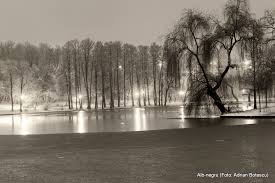The beautiful of old

The Cișmigiu Gardens or Cișmigiu Park (Romanian: Grădinile Cișmigiu or Parcul Cișmigiu) are a public park near the center of Bucharest, Romania, spanning areas on all sides of an artificial lake. The gardens' creation was an important moment in the history of Bucharest. They form the oldest and, at 16 hectares, the largest park in city's central area. The main entrance is from Regina Elisabeta Boulevard, in front of the City Hall; there is another major entrance at the Știrbei Vodă Street, near the Crețulescu Palace. The southwestern corner of the park is adjacent to the Gheorghe Lazăr High School.
History
The park was built in 1847, at a time when Bucharest was the capital of Wallachia, on a site formerly known as Lacul lui Dura neguțătorul (the "Lake of Dura the merchant"), or simply as Dura. The pool it replaced was a popular site for fishing from as early as the 17th century, and was inhabited by mallard colonies. A part of the present-day gardens was occupied by a vineyard, which was planted around a water source: the latter had been tapped during the bubonic plague epidemic of 1795, when the two sons of Prince Alexander Mourousis took refuge in the largely uninhabited zone.
The decision to replace the lake was taken in 1846, during a period of Imperial Russian administration introduced by Regulamentul Organic. It was based on an earlier proposal made by Russian governor Pavel Kiselyov in 1830, and various small-scale works had first been undertaken in 1837. The initiative, countersigned by Prince Gheorghe Bibescu, was part of a series of major public works, and the plan dates back to 1844. On 27 February 1845, the area passed into public ownership through a princely decree.
In 1843, Bibescu had called on experts in horticulture and planning to join in the effort to restructure the city gardens; as a result, two citizens of the German Confederation, the horticulturist Wilhelm Friedrich Carl Meyer and his assistant, the gardener Franz Hörer, arrived in Bucharest, where their first work involved the floral arrangements on each side of Șoseaua Kiseleff. They were to become involved in redesigning Dura area: Meyer was responsible for setting up the new lanes, for planting new floral species, as well as for setting up a Romantic landscape with rocks leading down to the lake. The central lake was connected to the Dâmbovița River through a canal. The gardens were ultimately inaugurated on 23 September 1847, and Meyer was appointed their administrator in 1848.
The word cișmigiu comes from Turkish: a Ceșme is a public fountain and a cișmigiu (or cișmegiu) used to be the person responsible for building and maintaining public fountains. The name replaced older references to Dura, and was coined by the public because, at the time, the administrator of Bucharest fountains was living on park grounds (in a house located between the central lake and Sărindar quarter).
Cișmigiu continued to be developed by Meyer long after its official inauguration: in 1870, the horticulturist laid out a plan to redesign the lanes, to introduce an artesian aquifer, and to create a kiosk for an orchestra. He also proposed to have gondolas carrying visitors over the lake. By 1851, new species of trees were brought in: chestnuts from Gorj County, walnuts from Dâmboviţa County, and other plants from places such as Vienna and Brașov. At the same time, the lanes were reinforced with debris from the ruins of Curtea Nouă and Zlătari area.[3] Works were completed despite Meyer's sudden death as a result of typhoid fever (August 1852).
The park was clearly delimited after Bucharest became capital of the Romanian Kingdom: in 1871, Academiei Boulevard was extended to its western side, and, in 1890, under Mayor Pache Protopopescu, Elisabeta Boulevard was created on its southern side. During the 1860s, Bucharest was visited by the socialist activist and philosopher Ferdinand Lassalle, who argued that "Cișmigiu exceeds by far anything Germany has to offer".
In 1882, the gardens were fitted with electrical lighting. Seven years later, the Gheorghe Lazăr High School was built on its southwestern corner (it was to be extended during the 1930s). During the late 19th and early 20th century, Cișmigiu became noted for housing the Thierry Restaurant, kept by a Frenchman, and various amateur photographers who made affordable portraits. The building in front of the park was assigned to the City Hall during the communist regime.
Meyer was succeeded in his office of garden administrator by other Germans: Ulrich Hoffman, Wilhelm Knechtel, and Friedrich Rebhuhn. It was Rebhuhn who, after 1910, redesigned many parts of the gardens to their present-day appearance.


Congratulations @titusmarian! You received a personal award!
You can view your badges on your Steem Board and compare to others on the Steem Ranking
Vote for @Steemitboard as a witness to get one more award and increased upvotes!